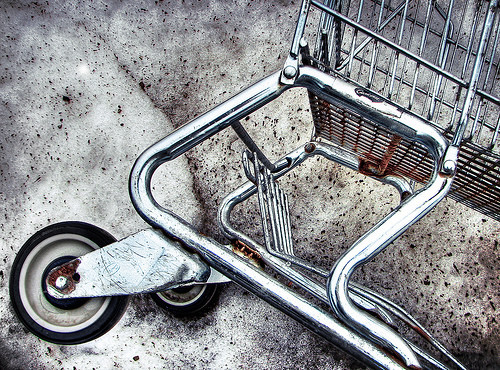This weekend I was paying for the 10 gallons I had just put into my old 1997 Honda Civic, when I decided that I’d purchase a nice cold soda for the road. I pointed out the pump where my fueled-up car was located and then slid the cold beverage to the convenience store clerk. He informed me that my total came to $25.89 and then he stopped.
Looking me dead in the eyes, he asked me what my name was. “Austin,” I replied a little hesitantly. “Austin, are you sure you want to spend $25.89 for 10 gallons of gas and a cold soda?” he asked. I nodded and attempted to hand him my Visa credit card.
He denied my overture and informed me that he could only help me if I were a member of his store. So not wanting to cause a scene with the five people who were now behind me, I conceded.
 Can I just buy a soda?
Can I just buy a soda?
He asked for my name again, and then moved on to more personal information. He informed me that my phone number, home address, and email address were all required for membership, but then gave me the option of telling him my age, date of birth, marital status, and household income level.
I, of course, declined. After all the information had been gathered, the clerk then passed me about 60 pages of the legal terms which I needed to sign to become a member.
Finally he took my card. However, in the middle of processing it, another clerk approached me saying that he noticed I was purchasing a can of soda. The coworker then made some suggestions concerning what I might like to buy along with my soda based upon previous customer patterns.
Once I had assured his coworker that I just wanted a soda, the clerk then again reminded me that my total came to $25.89 and again stopped, looked me dead in the eyes and asked, “Austin, are you sure you want to spend $25.89 for 10 gallons of gas and a cold soda?”
This might be how customers see our shopping carts
Ok, so this story is a bit of a stretch for a convenience store, but is an accurate reenactment of the experience at many ecommerce sites. This is exactly what we see across the Web with shopping cart experiences everywhere. In fact, we recently ran a test with one of our Research Partners and here is what the original checkout process looked like:
1) Product page (click to purchase)
2) Cart page (confirm you are ready to order)
3) User account page (if you are new you must choose to create a new account)
4) Create a user account page #1 (enter name, email and account password)
5) Create a user account page #2 (enter shipping information)
6) Create a user account page #3 (enter payment information)
7) Order confirmation page (confirm order and account information again)
8) Receipt page
To go from the product page to the receipt page took eight different steps. A customer has to register before being able to place the order, as well as confirm that order twice. After reorganizing and removing unnecessary steps, we were able to optimize this process to a single basic step. The increase in order completions was over 68%.
Is your shopping cart trying to do too much?
What this experiment illustrates is something we see over and over in the shopping cart process. Most shopping carts that companies use are bulky and have more features than needed (i.e. cart registration, order confirmations, cross-promotional offerings, etc.). Sometimes this means a shopping cart looks less like a basic transaction facilitator, and more like a boot camp obstacle training course with high walls and flaming hoops.
For instance, how many times have you had to join a web site before actually buying a product? How many “if you like this product, you might like this product” offers have you endured while checking out? Have you ever counted how many times you actually have to confirm your order before it goes through?
None of these features are bad per se, and some might even be helpful in the overall customer-client relationship. The only problem is when they get in the way of the natural thought sequence of a customer looking to purchase something at a specific moment in time.
Please, just let me out of here!
If I come to a web site, place an order in my cart, and hit “check out,” then please just let me check out. We must make sure our cart processes is sticking to the main objective – namely, closing the sale.
All these customer retention features and cross-promotional options can be strategically accomplished after the initial sale has already been completed. For instance, you can ask for the customer to create an account for future purchases or send them to a thank-you page that has cross-promotional offers.
Overall, this experiment leaves us with one key question: How many people might we be losing in the process by interrupting their order process? For this company, simplifying the checkout process meant 68% more orders. What is your potential?
Want to learn more?
For more information on how to optimize your shopping cart process, listen to our good friend Joel Book, the Director of eMarketing Education at ExactTarget and Charles Nicholls, the Founder of SeeWhy, in the free webinar entitled The 7 Secrets To Recovering Abandoned Shopping Carts.
Photo: http://www.flickr.com/photos/rickharris/ / CC BY-SA 2.0




Austin – great way to drive the point home! I tried to get to the free Webinar, but it says it’s no longer available. Do you have a direct link?
Playing a little devil’s advocate here…what about shopping cart abandonment and the theory that it’s prudent to capture an email address before the sale in case the customer decides to back out? You at least have a way to reconnect to them in order to hopefully complete the sale at a later date? Thoughts?
Nice question.
Overall, my point is that we need to make shopping carts easy as pie for our customers. Now, this doesn’t mean everything has to be done in one step. You can definitely test basket recovery methods; we certainly have found it beneficial is some instances (longer sale cycles/higher cost items).
But my opinion is that if we are selling the average ecommerce product with a clean and simple shopping cart, abandonment is not something we should fear. If our carts are done right we won’t have to set traps for our customers. A cart’s main objective is to facilitate a transaction (or value exchange). If we find that people are jumping ship in the process 1) Your customer doesn’t get the value of your product or 2) Your customer is annoyed at your cart process. We should fix these issues first when addressing abandonment. Make sense?
Now the caveat is that some products or sales cycles require nurturing, many steps, and much more information than a credit card number. For these instances, it makes sense and even serves the customer if you can capture their contact info first in case they have an issue during the cart process. But again, we are talking about $20,000 cranes, not a $20 box of chocolates.
I hope that is helpful. Thanks for the question Kevin.
@Cris Rominger
Chris, here is the link to a recording of the presentation:
http://www.screencast.com/t/Yzc2NTU5
I guess you need to ask yourself: are my clients returning clients who would benefit from storing their data (address etc.) in our system so as not to fill it in again?
In Spain (where I live), when you want to declare a gasoline – or any – purchase, you have to give them about 10 pieces of information to get a legally deductible receipt. Our local station used to ask for this each time until recently when they installed a new system that stored our data. I’m happy they did this, even if we had to hold up 3 other people in line to get the data into the system the first time.
@Mike Papageorge
Storing visitor data can be a great service or a great annoyance depending on the situation and the customer profile. So, how do we know when it is a service or an annoyance?
The good news is we don’t have to choose between one and the other. We can provide the customer the ability to create an account and store their information for future purchases after the sale has been processed. This not only serves the one who just wants to get through the cart, but it also serves the one who might plan to come back multiple times and would like to create account for ease later.
Unless you are sure that everyone (like those wanting deductible receipts in Spain) would appreciate their info stored, we shouldn’t force everyone to do it. Providing options is the best route in my opinion.
Great point and illustration Mike. Thanks for adding to the conversation.
Excellent point Austin. We’re in the process of redesigning our entire cart process and it certainly makes more sense to let them buy & then give them the option to create an account. They’re going to essentially have an account either way, but better to just let them buy & do the upsells after we’ve already gained their trust of the initial purchase. We did a test a few years ago that proved that reducing the checkout process by 1 step actually hurt overall conversion, but I think redesigning it entirely could change that. For larger ticket purchases, people seem more comfortable with a more involved process, as their instincts tell them it shouldn’t be that easy to spend $2000+. As people get more comfortable buying online, they’ll just want it fast & easy.
Have you done any evaluation of the various software packages that email abandoned carts that made it far enough to enter their email address? I have seen the study of the effectiveness of such emails but I am looking for information on the various software packages and features so I can decide what is most important. There is a primitive function in our e-commerce package that can send emails to abandoned carts but I am afraid it is missing some of the key features that would make these emails effective. Thanks! Sarah
Talking about a bricks-and-mortar store is a great way to help people think clearly.
In the online world we can learn a lot from offline stores – but we have a secret weapon of our own. It’s called testing. Testing is not a one-off process – its a state of mind. Keep testing new things, changes, ideas copied from elsewhere. Some work and some don’t. You dump the failures and keep going with the successes – all the time ratcheting conversions upwards.
Like compound interest it gets better and better.
I’m looking for the same thing as Sarah. Is there a review of stand alone cart abandonment response packages? Do all the good cart providers now have all the functionality you need? Thanks for the help.
88% of customers in 2010 admit to abandoning a shopping cart at one point. These are great tips that we can offer clients here at Dydacomp as was to avoid shopping cart abandonment.
Check out this blog about creating effective re-marketing techniques for abandon shopping carts:
http://blog.dydacomp.com/increase-your-return-on-abandoned-shopping-carts
Thanks for these!
Molly Griffin
Dydacomp
nice article..thanks, where do you draw the line between too many shopping cart add ons and legit ways to help customers receive pertinent options?
Great observations and really helpful article. It becomes obnoxious and not worth your time to spend your money at a site when the act of making the transaction is too difficult. Same with being in a brick and mortar shop and they make you uncomfortable for not joining their “club”.